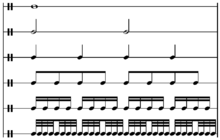Thirty-second note




In music, a 32nd note (American) or demisemiquaver (British) is a note played for 1/32 of the duration of a whole note (or semibreve). It lasts half as long as a 16th note (or semiquaver) and twice as long as a 64th (or hemidemisemiquaver).
32nd notes are notated with an oval, filled-in note head and a straight note stem with three flags or beams.[1] As with all notes with stems, 32nd notes are drawn with stems to the right of the notehead, facing up, when they are below the middle line of the musical staff. When they are on or above the middle line, they are drawn with stems on the left of the note head, facing down. Flags are always on the right side of the stem, and curve to the right. On stems facing up, the flags start at the top and curve down; for downward facing stems, the flags start at the bottom of the stem and curve up. When multiple 32nd notes or eighth notes (or 16ths, etc.) are next to each other, the flags may be connected with a beam. Similar rules apply to smaller divisions such as 64th notes.
A related symbol is the 32nd rest or demisemiquaver rest (shown to the right), which denotes a silence for the same duration.
The names of this note (and rest) in European and non-European languages vary greatly:
| Language | note name | rest name |
|---|---|---|
| Catalan | fusa | silenci de fusa |
| Chinese | 三十二分音符 (pinyin: sānshíèrfēn yīnfú) | 三十二分休止符 (pinyin: sānshíèrfēn xiūzhǐfú) |
| Danish | toogtredivte node | toogtredivte pause |
| Dutch | tweeëndertigste noot | tweeëndertigste rust |
| French | triple-croche | huitième de soupir |
| German | Zweiunddreißigstelnote | Zweiunddreißigstelpause |
| Italian | biscroma | pausa di biscroma |
| Korean | 32분음표(三十二分音標 samsipibun eumpyo) | 32분쉼표(三十二分-標 samsipibun swimpyo) |
| Norwegian | trettitodelsnote | trettitodelspause |
| Polish | trzydziestodwójka | pauza trzydziestodwójkowa |
| Portuguese | fusa | pausa de fusa |
| Russian | тридцать вторая нота | тридцать вторая пауза |
| Serbian | tridesetdvojin(k)a / тридесетдвојин(к)а | tridesetdvojinska pauza / тридесетдвојинска пауза |
| Spanish | fusa | silencio de fusa |
"Fusa" derives from the mensural notation corresponding to the modern eighth note.